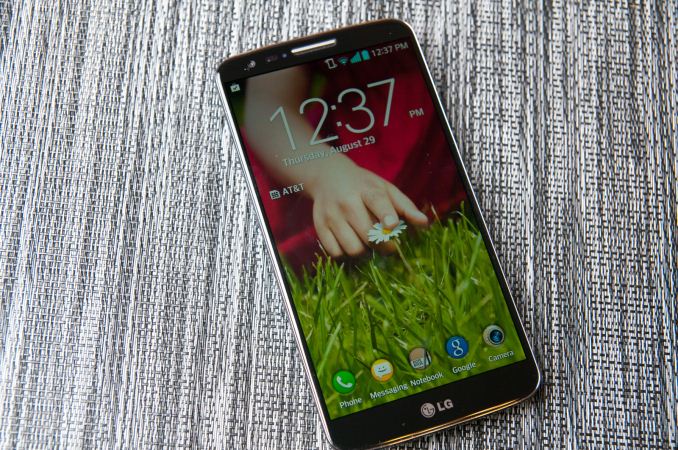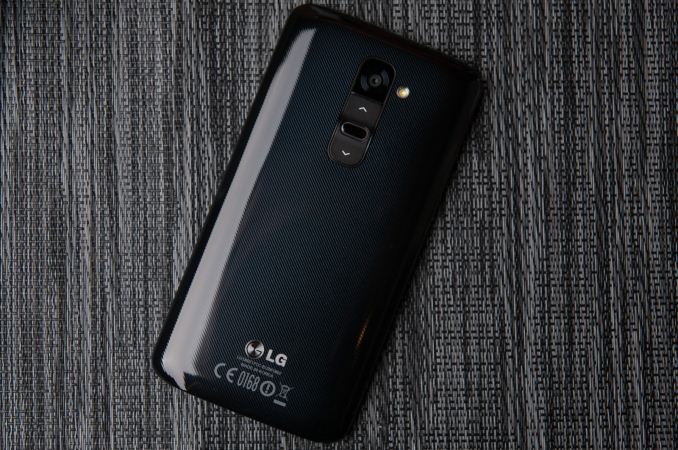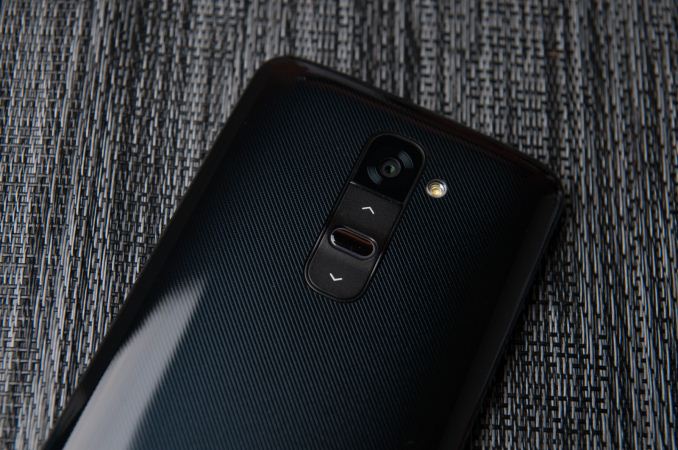LG G2 and MSM8974 Snapdragon 800 - Mini Review
by Brian Klug on September 7, 2013 1:11 AM EST- Posted in
- Smartphones
- LG
- Mobile
- LG G2
- Android 4.2
- MSM8974
- Snapdragon 800

The LG G2 is the spiritual successor to the Optimus G, a device that we looked at last year and eventually went on to become the Nexus 4. LG dropped the "Optimus" branding this time, but the G2 is without a doubt still LG's flagship smartphone, and includes a number of unique LG features – stacked 3000 mAh (11.4 Whr) battery with SiO+ anode, 5.2-inch 1080p LCD from LG Display, and 13 MP rear facing camera with OIS (Optical Image Stabilization). It's an impressive combination of features that make the G2 a standout device. At the same time the G2 is our first chance to get a look at the 2.3 GHz bin of Snapdragon 800 inside a shipping device and get a look at performance and battery life.
We took a quick look at the G2 at the announcement event, now we have our hands on a G2 and have been putting it through its paces, benchmarking it, and running battery life tests on it for a little under a week and wanted to share some thoughts.
Hardware Impressions
The G2 marries a curved backside shape with front glass that slightly curves at the edges and has a very narrow side bezel. The G2 also opts for on-screen buttons rather than the discrete capacitive kind or physical buttons that went out of favor a while ago. The reality is that Google does have a fair amount of input into at least this part of the Android ecosystem, and its guidance seems to be that on-screen buttons which use display real estate to draw the buttons is the recommended way to go. The G2 does afford the ability however to add Quick Memo buttons or the notification shade pull down/pull up buttons to the bar, but oddly enough there's no multitasking button option available.
The G2 manages to include a large display without width that's much different from other devices I've been using lately, like the HTC One. Part of getting the edge bezel small was a reduction in volume required on the sides for volume and power buttons, which are instead moved to the back of the G2, perhaps its most striking and initially even alarming design change.
Holding down the volume down button launches you into the camera, pressing the center button powers on the phone, and holding down the top button launches QuickMemo. Up and down are volume up and down otherwise. There's a hard raised lip on both sides of the button too, so the G2 when laid backside down on a surface makes contact there instead of on the button – it won't inadverntely turn on when pressed against a table. I found the backside buttons easy to adapt to after my first few interactions with the G2, and they actually become second nature after a day or so. The raised bump for the power button makes it easy to locate with the index finger, and I haven't smeared or accidentally put my finger on the sapphire camera cover yet. If the power button on the back is still difficult to get used to, the G2 has a double tap to turn on feature it calls "knock knock" – double tap on the display, and the G2 will turn on, repeat the double tap on the status bar or in an empty part of the display when it's on, and it turns off. I find myself using the double tap gesture quite a bit to turn the G2 on and off. I believe this functionality uses the sensors onboard and the DSP inside 8974 to detect when the taps occur.
The G2 I was sampled is a dark blue color which has a slight pinstripe on the back as shown in the photos above. The material is however the same kind of glossy plastic I'm used to seeing out of the Korean handset makers of note, and picks up fingerprints and hand oil very quickly unfortunately. I like the shape of the device and LG's innovations, it's just puzzling to me that materials hasn't picked up yet, I'd even take glass from the Optimus G over plastic. I'll save you the huge discussion on device size as well, I'm fine with the larger smartphones that aren't quite phablets, and the G2 for me is totally usable and I appreciate the increased display size. It definitely isn't phablet size, but it is on the larger high-end smartphone side of things.
| LG G2 | |
| SoC |
Qualcomm Snapdragon 800 (MSM8974) 4x Krait 400 2.3 GHz, Adreno 330 GPU |
| Display | 5.2-inch IPS-LCD 1920x1080 Full HD |
| RAM | 2GB LPDDR3 800 MHz |
| WiFi | 802.11a/b/g/n/ac, BT 4.0 |
| Storage | 32 GB internal |
| I/O | microUSB 2.0, 3.5mm headphone, NFC, Miracast, IR |
| OS | Android 4.2.2 |
| Battery | 3000 mAh (11.4 Whr) 3.8V stacked battery |
| Size / Mass | 138.5 x 70.9 x 9.14 mm |
| Camera |
13 MP with OIS and Flash (Rear Facing) 2.1 MP Full HD (Front Facing) |



















120 Comments
View All Comments
neoraiden - Sunday, September 8, 2013 - link
I was considering the qx100 but the price is out of my range as I don't take enough photographs to spend that much, am considering the qx10 though at that price point I wonder if a canon 240hs would suffice.Arnulf - Saturday, September 7, 2013 - link
"Gone are the days of 1.4V to hit near-2GHz frequencies it seems, instead 8974 will hit 2.3 GHz at around 1V"About fuggin time - my 2006 vintage 65 nm Core2 runs at 2.13 GHz at less than 1.1V. I was under the impression that smaller lithography process allows for lower voltages so they should have been well under 0.9V for 2 GHz by now.
Drumsticks - Saturday, September 7, 2013 - link
You are comparing two different companies' completely different CPUs, ARM vs x86 too. My 4670k will do 4ghz stable on a volt. The nature of smartphone SoCs vs full CPUs is very differentmadmilk - Saturday, September 7, 2013 - link
Your Core 2 also consumes 10 watts idling, despite the use of high-k dielectrics that TSMC only recently started using. HP trades off leakage for high clock speeds and low voltages.FwFred - Saturday, September 7, 2013 - link
You are comparing a platform with 3 discrete chips instead of one, and way more high voltage IO interfaces. Try a modern x86 SoC: Haswell ULT, Bay Trail, or Clover trail for a more fair comparison for idle power.His point was top clock speed vs. voltage. A completely different topic.
Krysto - Sunday, September 8, 2013 - link
From what I've read, it's becoming very hard to use the same litography process at smaller nodes, and they need to move to a new litography technology (ultraviolet litography, I think), but that's years away from being ready, too, and might not be until 14nm or even 10nm.unipidity - Saturday, September 7, 2013 - link
I would just like to comment that articles like this are one of the reasons Anandtech will continue to get my traffic long into the future. Brian's "mini-review" is head and shoulders above any "full" review I come across on most tech review sites. Anandtech is never ever first to print, at least on phones, but when it comes to properly informing my purchasing decisions, nothing comes else comes close. Keep up the good work.Impulses - Saturday, September 7, 2013 - link
+1000UltraWide - Saturday, September 7, 2013 - link
Why are the comparison devices different throughout the tests?This inconsistency makes it hard to compare the G2 to another device.
nerd1 - Saturday, September 7, 2013 - link
Funny fact is the domestic version of G2 supports both microSD and switchable battery (albeit slight smaller). Obviously US customers are too tamed to apple devices and they won't need such features.